
Succimer
Descripción general
Descripción
A mercaptodicarboxylic acid used as an antidote to heavy metal poisoning because it forms strong chelates with them.
Mecanismo De Acción
Target of Action
Succimer, also known as meso-2,3-Dimercaptosuccinic acid, primarily targets heavy metals in the body . It has a high specificity for ions of lead, mercury, cadmium, and arsenic .
Mode of Action
This compound acts as a heavy metal chelator . It binds with high specificity to ions of lead in the blood to form a water-soluble complex . This complex is subsequently excreted by the kidneys . This compound can also chelate mercury, cadmium, and arsenic in this manner .
Biochemical Pathways
The biochemical pathways affected by this compound primarily involve the detoxification and excretion of heavy metals. By forming water-soluble complexes with heavy metals, this compound facilitates their removal from the body, thereby reducing the toxic effects of these metals .
Pharmacokinetics
This compound is orally active and is rapidly but variably absorbed . It forms water-soluble chelates and, consequently, increases the urinary excretion of lead . Chemical analysis of this compound and its metabolites (primarily mixed disulfides of L-cysteine) in the urine showed that this compound was rapidly and extensively metabolized .
Result of Action
The primary result of this compound’s action is the reduction of heavy metal toxicity in the body. By binding to heavy metals and facilitating their excretion, this compound helps to decrease the concentration of these toxic substances in the body . This can help to alleviate the symptoms of heavy metal poisoning and prevent further damage to the body’s tissues and organs .
Aplicaciones Científicas De Investigación
Quelación de Metales Pesados
Succimer se usa ampliamente para quelar metales pesados tóxicos como zinc (Zn), cadmio (Cd) y plomo (Pb) de soluciones acuosas contaminadas. Forma una monocapa en micromotores Mg/Ti/Au, mejorando el proceso de quelación .
Síntesis de Cúmulos Protegidos por Monocapa
Actúa como agente reductor y estabilizador en la síntesis de cúmulos de oro protegidos por monocapa. Estos cúmulos tienen un potencial significativo en diversas aplicaciones de nanotecnología .
Sistemas de Administración de Medicamentos
This compound se ha utilizado para la carboxilación terminal de nanopartículas de Fe3O4 recubiertas de oleilamina, que luego se utilizan para desarrollar sistemas de administración de fármacos dirigidos a la curcumina .
Nanopartículas Magnéticas de Óxido de Hierro
El compuesto encuentra aplicación en la funcionalización de nanopartículas magnéticas de óxido de hierro (IONPs), aprovechando sus propiedades magnéticas y actividad catalítica para diversos usos innovadores .
Radiofarmacia
En radiofarmacia, this compound forma complejos estables con una amplia gama de iones metálicos, lo cual es crucial para la preparación de radiofármacos utilizados en imágenes y terapia de diagnóstico .
Tratamiento de Intoxicaciones por Metales Pesados
Debido a sus propiedades quelantes de metales, this compound también se emplea en el tratamiento médico de intoxicaciones por metales pesados, ayudando a eliminar el exceso o los metales tóxicos del cuerpo .
Preparación de Nanopartículas
Las nanopartículas funcionalizadas con this compound tienen aplicaciones potenciales en sistemas de administración de fármacos y como agentes de calentamiento para tratamientos de hipertermia .
Análisis Bioquímico
Biochemical Properties
Succimer interacts with heavy metals in the body, forming strong chelates with them . This interaction is highly specific, particularly with ions of lead, mercury, cadmium, and arsenic . The nature of these interactions involves the binding of this compound to these heavy metal ions, forming a water-soluble complex that can be excreted by the kidneys .
Cellular Effects
This compound has a significant impact on various types of cells and cellular processes. Its primary function is to increase the urinary excretion of heavy metals, thereby reducing their concentration in the body . This can influence cell function by reducing the toxic effects of these heavy metals on cellular metabolism and gene expression .
Molecular Mechanism
The molecular mechanism of this compound involves its role as a heavy metal chelator. It binds with high specificity to ions of lead in the blood, forming a water-soluble complex that is subsequently excreted by the kidneys . Similarly, this compound can chelate mercury, cadmium, and arsenic in the same manner .
Temporal Effects in Laboratory Settings
The effects of this compound can change over time in laboratory settings. For instance, it has been shown that this compound treatment can produce lasting cognitive benefits if chelation sufficiently reduces brain lead levels .
Dosage Effects in Animal Models
In animal models, the effects of this compound can vary with different dosages. For instance, studies have shown that doses of 2300 mg/kg in rats and 2400 mg/kg in mice produced ataxia, convulsions, labored respiration, and frequently death . No case of overdosage has been reported in humans .
Metabolic Pathways
This compound is rapidly and extensively metabolized in the body, primarily to mixed disulfides of L-cysteine . This metabolic process occurs in the urine, where chemical analysis has shown that this compound and its metabolites are rapidly and extensively metabolized .
Transport and Distribution
This compound is primarily distributed extracellularly . After oral administration, absorption of this compound is rapid but variable . It is then distributed throughout the body, where it binds to heavy metal ions and forms water-soluble chelates .
Propiedades
IUPAC Name |
2,3-bis(sulfanyl)butanedioic acid | |
|---|---|---|
| Source | PubChem | |
| URL | https://pubchem.ncbi.nlm.nih.gov | |
| Description | Data deposited in or computed by PubChem | |
InChI |
InChI=1S/C4H6O4S2/c5-3(6)1(9)2(10)4(7)8/h1-2,9-10H,(H,5,6)(H,7,8) | |
| Source | PubChem | |
| URL | https://pubchem.ncbi.nlm.nih.gov | |
| Description | Data deposited in or computed by PubChem | |
InChI Key |
ACTRVOBWPAIOHC-UHFFFAOYSA-N | |
| Source | PubChem | |
| URL | https://pubchem.ncbi.nlm.nih.gov | |
| Description | Data deposited in or computed by PubChem | |
Canonical SMILES |
C(C(C(=O)O)S)(C(=O)O)S | |
| Source | PubChem | |
| URL | https://pubchem.ncbi.nlm.nih.gov | |
| Description | Data deposited in or computed by PubChem | |
Molecular Formula |
C4H6O4S2 | |
| Source | PubChem | |
| URL | https://pubchem.ncbi.nlm.nih.gov | |
| Description | Data deposited in or computed by PubChem | |
Related CAS |
304-55-2 (Parent) | |
| Record name | Dimercaptosuccinic acid | |
| Source | ChemIDplus | |
| URL | https://pubchem.ncbi.nlm.nih.gov/substance/?source=chemidplus&sourceid=0002418146 | |
| Description | ChemIDplus is a free, web search system that provides access to the structure and nomenclature authority files used for the identification of chemical substances cited in National Library of Medicine (NLM) databases, including the TOXNET system. | |
DSSTOX Substance ID |
DTXSID10859324 | |
| Record name | 2,3-Dimercaptobutanedioic acid | |
| Source | EPA DSSTox | |
| URL | https://comptox.epa.gov/dashboard/DTXSID10859324 | |
| Description | DSSTox provides a high quality public chemistry resource for supporting improved predictive toxicology. | |
Molecular Weight |
182.2 g/mol | |
| Source | PubChem | |
| URL | https://pubchem.ncbi.nlm.nih.gov | |
| Description | Data deposited in or computed by PubChem | |
Physical Description |
Solid | |
| Record name | Succimer | |
| Source | Human Metabolome Database (HMDB) | |
| URL | http://www.hmdb.ca/metabolites/HMDB0014706 | |
| Description | The Human Metabolome Database (HMDB) is a freely available electronic database containing detailed information about small molecule metabolites found in the human body. | |
| Explanation | HMDB is offered to the public as a freely available resource. Use and re-distribution of the data, in whole or in part, for commercial purposes requires explicit permission of the authors and explicit acknowledgment of the source material (HMDB) and the original publication (see the HMDB citing page). We ask that users who download significant portions of the database cite the HMDB paper in any resulting publications. | |
Solubility |
2.43e+00 g/L | |
| Record name | Succimer | |
| Source | Human Metabolome Database (HMDB) | |
| URL | http://www.hmdb.ca/metabolites/HMDB0014706 | |
| Description | The Human Metabolome Database (HMDB) is a freely available electronic database containing detailed information about small molecule metabolites found in the human body. | |
| Explanation | HMDB is offered to the public as a freely available resource. Use and re-distribution of the data, in whole or in part, for commercial purposes requires explicit permission of the authors and explicit acknowledgment of the source material (HMDB) and the original publication (see the HMDB citing page). We ask that users who download significant portions of the database cite the HMDB paper in any resulting publications. | |
CAS No. |
2418-14-6, 304-55-2 | |
| Record name | Dimercaptosuccinic acid | |
| Source | CAS Common Chemistry | |
| URL | https://commonchemistry.cas.org/detail?cas_rn=2418-14-6 | |
| Description | CAS Common Chemistry is an open community resource for accessing chemical information. Nearly 500,000 chemical substances from CAS REGISTRY cover areas of community interest, including common and frequently regulated chemicals, and those relevant to high school and undergraduate chemistry classes. This chemical information, curated by our expert scientists, is provided in alignment with our mission as a division of the American Chemical Society. | |
| Explanation | The data from CAS Common Chemistry is provided under a CC-BY-NC 4.0 license, unless otherwise stated. | |
| Record name | Dimercaptosuccinic acid | |
| Source | ChemIDplus | |
| URL | https://pubchem.ncbi.nlm.nih.gov/substance/?source=chemidplus&sourceid=0002418146 | |
| Description | ChemIDplus is a free, web search system that provides access to the structure and nomenclature authority files used for the identification of chemical substances cited in National Library of Medicine (NLM) databases, including the TOXNET system. | |
| Record name | Dimercaptosuccinic acid | |
| Source | DrugBank | |
| URL | https://www.drugbank.ca/drugs/DB14089 | |
| Description | The DrugBank database is a unique bioinformatics and cheminformatics resource that combines detailed drug (i.e. chemical, pharmacological and pharmaceutical) data with comprehensive drug target (i.e. sequence, structure, and pathway) information. | |
| Explanation | Creative Common's Attribution-NonCommercial 4.0 International License (http://creativecommons.org/licenses/by-nc/4.0/legalcode) | |
| Record name | 2,3-Dimercaptosuccinic acid | |
| Source | DTP/NCI | |
| URL | https://dtp.cancer.gov/dtpstandard/servlet/dwindex?searchtype=NSC&outputformat=html&searchlist=259951 | |
| Description | The NCI Development Therapeutics Program (DTP) provides services and resources to the academic and private-sector research communities worldwide to facilitate the discovery and development of new cancer therapeutic agents. | |
| Explanation | Unless otherwise indicated, all text within NCI products is free of copyright and may be reused without our permission. Credit the National Cancer Institute as the source. | |
| Record name | Butanedioic acid, 2,3-dimercapto- | |
| Source | EPA Chemicals under the TSCA | |
| URL | https://www.epa.gov/chemicals-under-tsca | |
| Description | EPA Chemicals under the Toxic Substances Control Act (TSCA) collection contains information on chemicals and their regulations under TSCA, including non-confidential content from the TSCA Chemical Substance Inventory and Chemical Data Reporting. | |
| Record name | 2,3-Dimercaptobutanedioic acid | |
| Source | EPA DSSTox | |
| URL | https://comptox.epa.gov/dashboard/DTXSID10859324 | |
| Description | DSSTox provides a high quality public chemistry resource for supporting improved predictive toxicology. | |
| Record name | 2,3-dimercaptosuccinic acid | |
| Source | European Chemicals Agency (ECHA) | |
| URL | https://echa.europa.eu/substance-information/-/substanceinfo/100.017.577 | |
| Description | The European Chemicals Agency (ECHA) is an agency of the European Union which is the driving force among regulatory authorities in implementing the EU's groundbreaking chemicals legislation for the benefit of human health and the environment as well as for innovation and competitiveness. | |
| Explanation | Use of the information, documents and data from the ECHA website is subject to the terms and conditions of this Legal Notice, and subject to other binding limitations provided for under applicable law, the information, documents and data made available on the ECHA website may be reproduced, distributed and/or used, totally or in part, for non-commercial purposes provided that ECHA is acknowledged as the source: "Source: European Chemicals Agency, http://echa.europa.eu/". Such acknowledgement must be included in each copy of the material. ECHA permits and encourages organisations and individuals to create links to the ECHA website under the following cumulative conditions: Links can only be made to webpages that provide a link to the Legal Notice page. | |
| Record name | Succimer | |
| Source | Human Metabolome Database (HMDB) | |
| URL | http://www.hmdb.ca/metabolites/HMDB0014706 | |
| Description | The Human Metabolome Database (HMDB) is a freely available electronic database containing detailed information about small molecule metabolites found in the human body. | |
| Explanation | HMDB is offered to the public as a freely available resource. Use and re-distribution of the data, in whole or in part, for commercial purposes requires explicit permission of the authors and explicit acknowledgment of the source material (HMDB) and the original publication (see the HMDB citing page). We ask that users who download significant portions of the database cite the HMDB paper in any resulting publications. | |
Melting Point |
193 °C | |
| Record name | Succimer | |
| Source | Human Metabolome Database (HMDB) | |
| URL | http://www.hmdb.ca/metabolites/HMDB0014706 | |
| Description | The Human Metabolome Database (HMDB) is a freely available electronic database containing detailed information about small molecule metabolites found in the human body. | |
| Explanation | HMDB is offered to the public as a freely available resource. Use and re-distribution of the data, in whole or in part, for commercial purposes requires explicit permission of the authors and explicit acknowledgment of the source material (HMDB) and the original publication (see the HMDB citing page). We ask that users who download significant portions of the database cite the HMDB paper in any resulting publications. | |
Retrosynthesis Analysis
AI-Powered Synthesis Planning: Our tool employs the Template_relevance Pistachio, Template_relevance Bkms_metabolic, Template_relevance Pistachio_ringbreaker, Template_relevance Reaxys, Template_relevance Reaxys_biocatalysis model, leveraging a vast database of chemical reactions to predict feasible synthetic routes.
One-Step Synthesis Focus: Specifically designed for one-step synthesis, it provides concise and direct routes for your target compounds, streamlining the synthesis process.
Accurate Predictions: Utilizing the extensive PISTACHIO, BKMS_METABOLIC, PISTACHIO_RINGBREAKER, REAXYS, REAXYS_BIOCATALYSIS database, our tool offers high-accuracy predictions, reflecting the latest in chemical research and data.
Strategy Settings
| Precursor scoring | Relevance Heuristic |
|---|---|
| Min. plausibility | 0.01 |
| Model | Template_relevance |
| Template Set | Pistachio/Bkms_metabolic/Pistachio_ringbreaker/Reaxys/Reaxys_biocatalysis |
| Top-N result to add to graph | 6 |
Feasible Synthetic Routes
Q1: How does succimer interact with lead in the body?
A1: this compound exerts its chelating action by forming stable, water-soluble complexes with lead. [] This interaction occurs primarily via the coordination of one sulfur atom and one oxygen atom of the this compound molecule with a lead ion. []
Q2: How does this compound affect the distribution of lead within the body?
A2: this compound facilitates the redistribution of lead from various tissues, including the blood, to the kidneys for excretion. [] Research in juvenile monkeys demonstrated that oral this compound significantly increased the urinary excretion of endogenous lead while decreasing fecal excretion. []
Q3: Does this compound effectively reduce lead levels in the brain?
A3: Research findings on the efficacy of this compound in reducing brain lead levels are mixed. While some studies in rodent models suggest that this compound can reduce brain lead levels, albeit to a lesser extent than blood lead levels, [, ] research in primates indicates that this compound may not significantly reduce brain lead beyond the reduction achieved by the cessation of lead exposure alone. []
Q4: What is the molecular formula and weight of this compound?
A4: The molecular formula of this compound is C4H6O4S2, and its molecular weight is 182.22 g/mol.
Q5: Is there spectroscopic data available for this compound?
A5: Several analytical techniques have been employed to characterize and quantify this compound. These include:* High-performance liquid chromatography (HPLC) coupled with fluorescence detection. [, , ]* Gas chromatography. []* Mass spectrometry (usually coupled with inductively coupled plasma for measuring metal concentrations). [, , ]
Q6: Does this compound exhibit any notable material compatibility issues?
A6: One documented concern is the adsorption of technetium-99m (99mTc)-labeled this compound to plastic syringes, potentially leading to inaccurate dosing. [, , ] This adsorption varies significantly depending on the syringe brand and preparation technique. []
Q7: How is this compound absorbed and distributed in the body?
A7: this compound is administered orally and has relatively good absorption from the gastrointestinal tract. [, , ] It exhibits an extracellular distribution pattern, which contributes to its lower toxicity profile compared to other dithiol chelating agents. []
Q8: What is the primary route of this compound elimination?
A8: this compound is primarily eliminated through the kidneys, with a significant portion of the administered dose excreted in the urine as unaltered this compound and its metabolites. [, , ] In humans, a significant portion of this compound is biotransformed into a mixed disulfide with cysteine before excretion. []
Q9: Has this compound been tested in clinical trials for lead poisoning?
A9: Yes, several clinical trials have evaluated the safety and efficacy of this compound for treating lead poisoning in children. [, , , , ] Results indicate that this compound effectively lowers blood lead levels but may not translate to significant improvements in cognitive or behavioral outcomes in children with moderate blood lead levels. [, , ]
Q10: Has this compound shown efficacy in treating other metal poisonings?
A10: While primarily studied for lead poisoning, case reports suggest that this compound might be a viable treatment option for other heavy metal poisonings, such as copper sulfate poisoning, especially in settings where other chelating agents are unavailable. [, ]
Q11: What are the common side effects of this compound therapy?
A11: Commonly reported side effects associated with this compound treatment are generally mild and include gastrointestinal symptoms like nausea, vomiting, diarrhea, and appetite loss. [] These effects may be linked to the drug's unpleasant mercaptan odor. []
Descargo de responsabilidad e información sobre productos de investigación in vitro
Tenga en cuenta que todos los artículos e información de productos presentados en BenchChem están destinados únicamente con fines informativos. Los productos disponibles para la compra en BenchChem están diseñados específicamente para estudios in vitro, que se realizan fuera de organismos vivos. Los estudios in vitro, derivados del término latino "in vidrio", involucran experimentos realizados en entornos de laboratorio controlados utilizando células o tejidos. Es importante tener en cuenta que estos productos no se clasifican como medicamentos y no han recibido la aprobación de la FDA para la prevención, tratamiento o cura de ninguna condición médica, dolencia o enfermedad. Debemos enfatizar que cualquier forma de introducción corporal de estos productos en humanos o animales está estrictamente prohibida por ley. Es esencial adherirse a estas pautas para garantizar el cumplimiento de los estándares legales y éticos en la investigación y experimentación.


![7-[(5-acetamido-5-carboxypentanoyl)amino]-3-[[4-[[(2S)-1-[[(2S)-2-[[(2S)-2-acetamidopropanoyl]amino]propanoyl]amino]-1-oxopropan-2-yl]amino]-7-(diaminomethylideneamino)-3-hydroxyheptanoyl]oxymethyl]-7-formamido-8-oxo-5-thia-1-azabicyclo[4.2.0]oct-2-ene-2-carboxylic acid](/img/structure/B1681085.png)
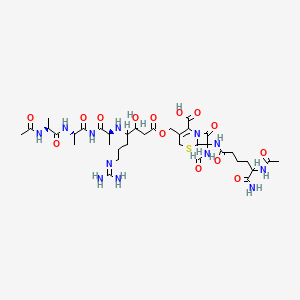
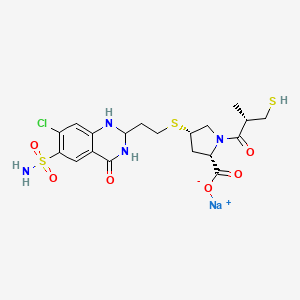
![tert-butyl N-[(2S)-1-[[(2S)-2-[[(1R,2S)-3-cyclohexyl-1-hydroxy-1-(1H-imidazol-2-yl)propan-2-yl]amino]-3-(1H-imidazol-5-yl)propanoyl]amino]-1-oxo-3-phenylpropan-2-yl]carbamate](/img/structure/B1681089.png)
![N-[(2S)-1-[[(2S)-2-[[(1R,2S)-3-cyclohexyl-1-hydroxy-1-(1H-imidazol-2-yl)propan-2-yl]amino]-3-(1H-imidazol-5-yl)propanoyl]amino]-1-oxo-3-phenylpropan-2-yl]morpholine-4-carboxamide](/img/structure/B1681090.png)
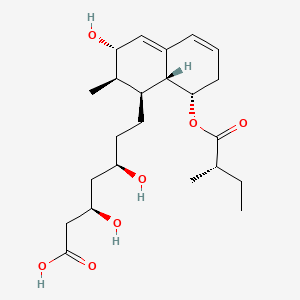
![(2S)-N-[(2S)-2-(6-aminohexanoylamino)-3-phenylpropanoyl]-2-[[(1R,2S)-3-cyclohexyl-1-hydroxy-1-(1,3-thiazol-2-yl)propan-2-yl]amino]-4-methylpentanamide](/img/structure/B1681095.png)
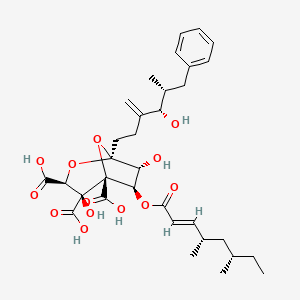
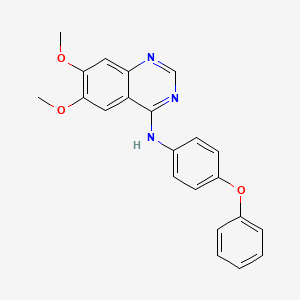

![3,4,5-trimethoxy-N-(2-(3-(piperazin-1-ylmethyl)imidazo[2,1-b]thiazol-6-yl)phenyl)benzamide](/img/structure/B1681105.png)
![5-Thiazolecarboxamide, 4-methyl-N-[2-[3-(4-morpholinylmethyl)imidazo[2,1-b]thiazol-6-yl]phenyl]-2-(3-pyridinyl)-](/img/structure/B1681106.png)
![(R)-N-(2-(3-((3-hydroxypyrrolidin-1-yl)methyl)imidazo[2,1-b]thiazol-6-yl)phenyl)-2-naphthamide](/img/structure/B1681107.png)

